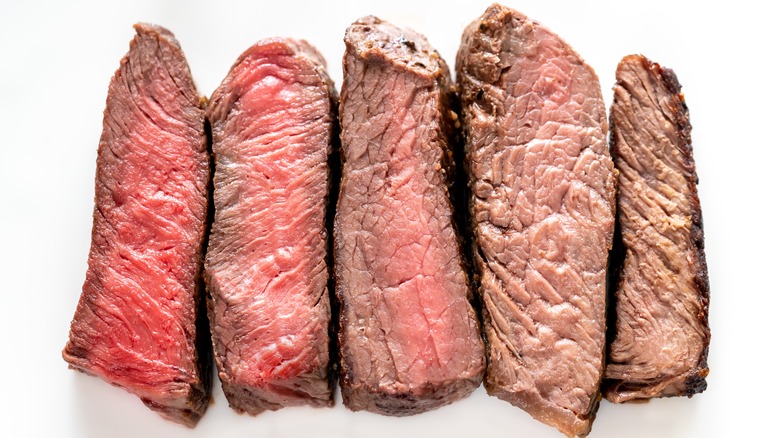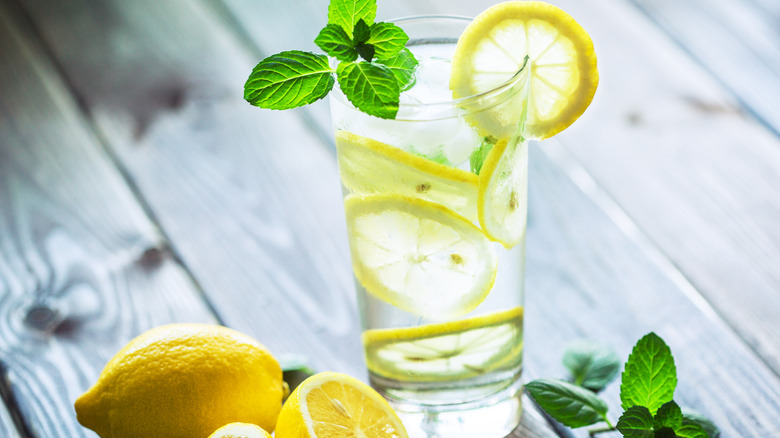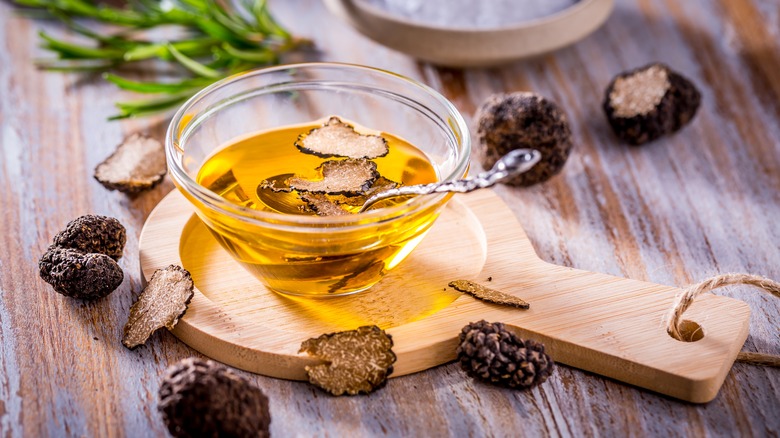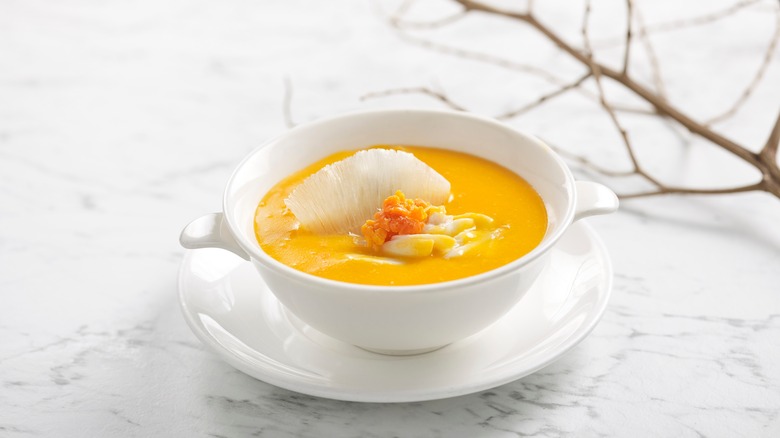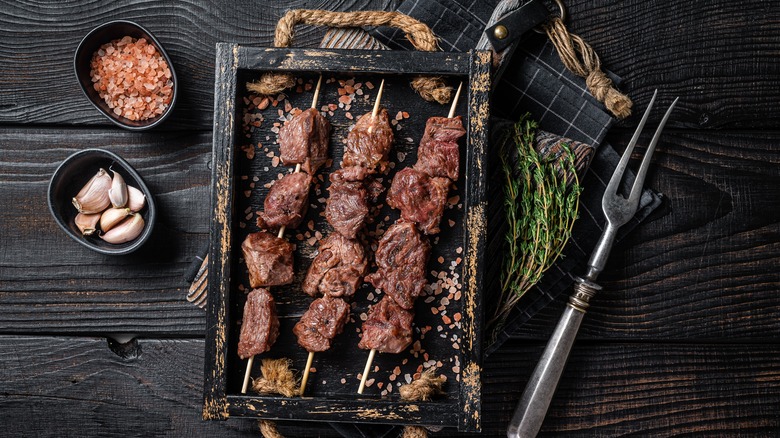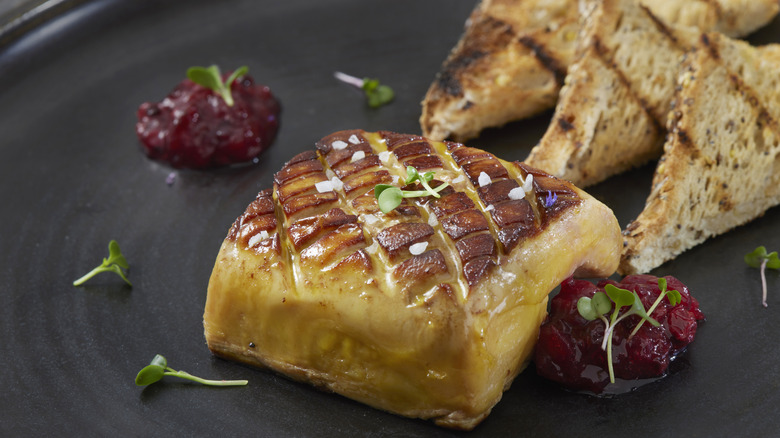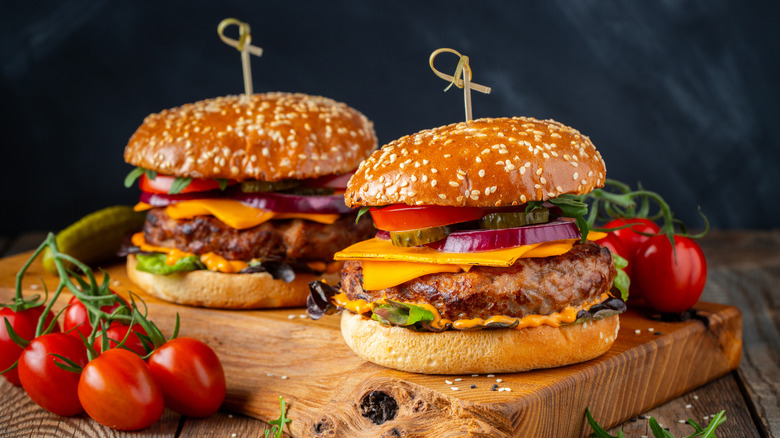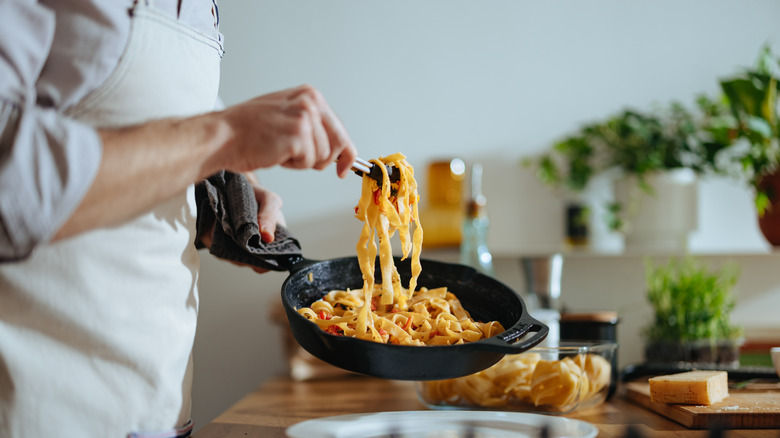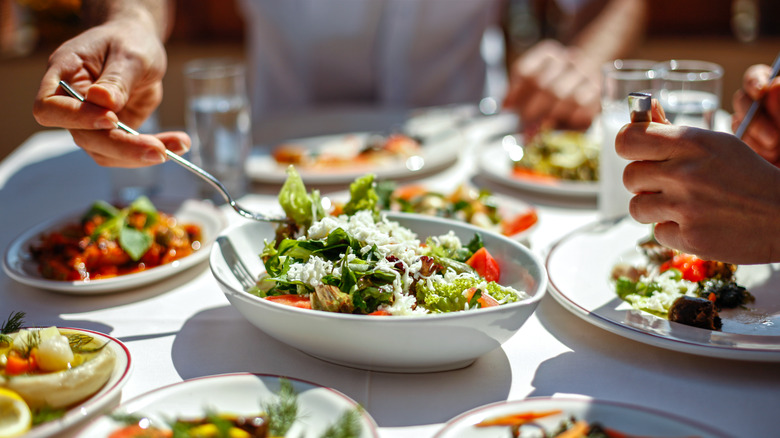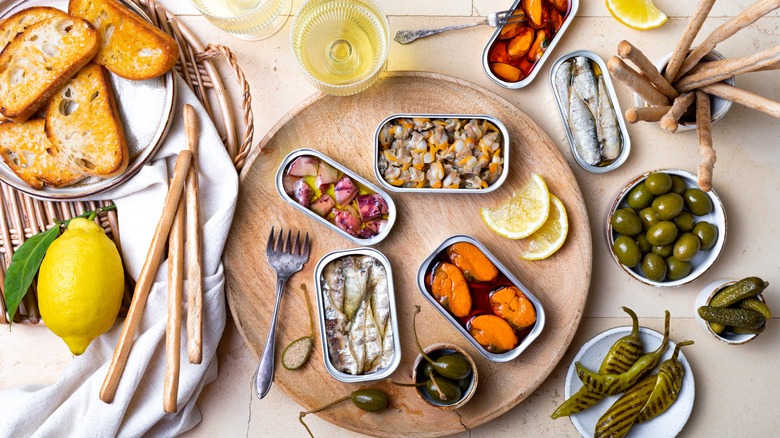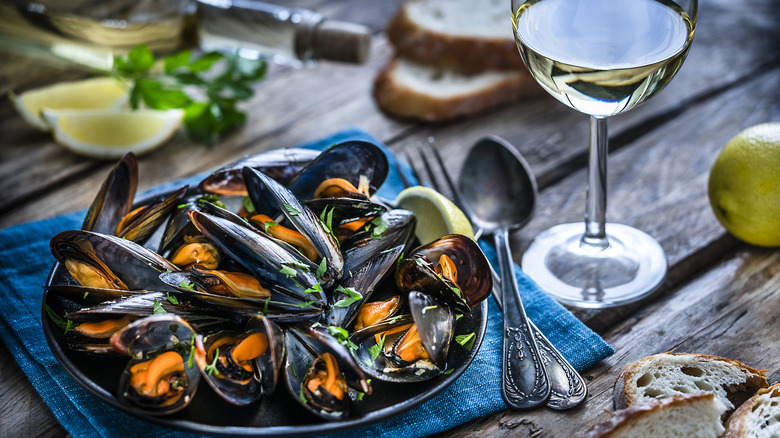Foods You Should Think Twice About Ordering At A Fancy Restaurant
Fine dining can be a delicious and enjoyable experience. Eating out at an acclaimed restaurant offers the chance to enjoy some of your favorite dishes created by skilled chefs or to broaden your palate by experiencing cuisine or flavors you've never tried before. Indulging in a well-prepared meal is the perfect way to treat yourself and spend quality time with loved ones. However, this beautiful experience can turn sour if you make the wrong choice when ordering.
There's a lot to consider at a nice restaurant, from etiquette rules to what to eat. We've all had the disappointing experience of picking the wrong menu item and then spending the meal feeling jealous of everyone else's food. This is even more painful at a fancy restaurant, where you'll likely have paid quite a bit for the lackluster dish. Although most of the menu at an upscale dining establishment will leave you thoroughly impressed, some options are better to avoid. Some aren't worth the money, others may make you sick, and others just won't offer the best flavor. Through researching the advice of chefs and restaurant critics and looking into health factors, we've compiled a list of 12 things never to order at a fancy restaurant so you can avoid that disappointment.
Well-done steak
For most of us, an expensive cut of steak isn't something we get to enjoy on a regular basis. However, eating at a high-end restaurant is the perfect time to indulge and order a porterhouse, sirloin, or rib-eye. Steak dinners are the ideal dish for a date night or special occasion, and you can get some of the best cuts of meat prepared beautifully at upscale steak houses and restaurants. However, ordering your steak well done is a good way to ruin the meat and earn the contempt of the kitchen staff.
Cooking steak until well done can dry out the meat and ruin its tender, juicy flavor. Because the meat needs to be heated so much longer for a well-done steak, the natural juices escape the beef, and the fibers can become unpleasantly chewy and tough. Because of its unappetizing results, many chefs consider well-done steak to be a waste of good meat. Chef Anthony Bourdain shared his disdain for well-done steak in his memoir "Kitchen Confessional," even saying that his kitchen staff set aside the worst cuts for well-done orders (via The New Yorker).
You may still not be a fan of bloody or rare steak. But consider ordering your steak medium. This way, the meat will be slightly more well done, but it won't become tough and dry.
Lemon water
Going out to a nice restaurant can land you with quite the bill. If you're looking for an easy way to make your order more affordable, you may decide to stick to drinking water. Although this is a budget-conscious and healthy choice, drinking plain water may feel a little lackluster. Adding a slice of lemon seems like the perfect way to enhance the bland water with a pop of color and refreshing flavor. Unfortunately, lemon water can be very unsanitary at restaurants.
Although it may taste fresh, studies have found that lemon water tends to be anything but. Lemons are often one of the most germ-filled foods in restaurant kitchens. Chefs, bartenders, servers, and other staff are typically grabbing and touching the lemons, both with and without gloves on. This isn't merely speculation: A study in the Journal of Environmental Health found that restaurant lemons (particularly lemon wedges) contain a shocking amount of micro-organisms on the rind and flesh, including E. coli, guilliermondii, and E. cloacae. The thought is enough to ruin anyone's enjoyment of lemon water.
You can, of course, still enjoy the water with your dinner and get the health and financial benefits that come from rehydrating and skipping alcoholic or sugary drinks. However, you might want to ask the staff to hold the lemon and just drink that water plain.
Truffle oil
Truffle oil is known for its rich aroma and complex flavor. It's often drizzled over dishes as a finishing touch and has become quite the culinary trend. You'll often see truffle fries, bruschetta with truffle oil, pasta with truffle oil, and other tempting dishes on restaurant menus. Part of its appeal, aside from flavor, is that truffles are considered a luxury food item. Real truffles are difficult to grow, making them scarce and expensive. Because of how rare and costly truffles are, adding truffle oil to the menu makes dishes seem like a delicacy. But truffle-flavored menu items may not be all they seem.
Because truffles are so pricey, commercial truffle oil is often made with olive oil and chemical compounds like 2,4-dithiapentane instead of actual truffles. This compound mimics the earthy flavor of truffles, but it doesn't quite capture all the complexity of the real stuff. Many restaurant kitchens use this chemical substitute to create their truffle dishes because it's far more cost effective for them. "Chefs use truffle oil because it's easy to add a gloss of glamour with it — and because it helps sell dishes," restaurant critic S. Irene Virbila told The New York Times. Because restaurants know truffle attracts consumers, they may include it on their menu at a high price. But more often than not, you're getting truffle flavoring and not real truffle oil.
Shark
Shark is not a common menu item. In fact, buying and selling shark fins is illegal in many countries and states. Even so, the meat's rarity may perk the interest of adventurous eaters. Shark meat is considered a delicacy in many parts of the world, often consumed in steaks or in the popular dish shark fin soup. Though it may be tempting, you should avoid this order for the environment and your health. A study published by The Guardian on the shark population off the coast of Queensland, Australia, found a drastic decline of 90% over five decades. The shrinking population of the predator is hugely detrimental to the ocean's ecosystem and attributed largely to commercial fishing. The high demand for shark fin meat has also led to a practice called finning, which involves slicing the valuable fins off of sharks before tossing them back into the water, where the animals will die. Finning is considered a cruel practice and is illegal in the US, but the ban can be hard to enforce.
What's more, eating shark meat can be quite unhealthy. Many seafoods contain mercury, and shark meat has quite a lot of it. A study done in the journal Exposure & Health on the health risks of shark products found that the meat contained concerningly high mercury levels, especially in hammerhead sharks. Mercury is hazardous to adults in high amounts and can be particularly dangerous for pregnant people, as it can harm fetal development (via Environment International).
Veal
Veal is known for its delicate flavor and texture, but there are some things you should know before you order this protein. Unlike regular beef dishes, which are from adult cows, veal comes from young calves, which has proven to be very controversial. Due to the calf's youth, the meat is said to be more succulent and have a milder flavor than beef. Calves are slaughtered when they are under a year old to be considered veal. Even for those who typically enjoy meat, the idea of eating a young calf may be unpleasant.
Apart from how young the animals are, the calf's short lifespan can be quite sad to imagine. They are separated from their mothers at a very young age, and their food and movement are heavily restricted, all for the sake of maintaining ultra-tender meat. This treatment has evoked conflict and anger in many animal rights activists. "Simply because a calf is destined to be slaughtered does not mean he should be forced to live a life of agony. A calf needs mother's milk. Sunshine. Freedom to move and play. A place to sleep in comfort," the Humane Farming Association said in a letter against the practice (via Washington Post). This has turned many folks off from ordering veal.
Foie gras
Foie gras is considered a delicacy, but the way it's made may turn your stomach, and it's another dish that many people abstain from for moral reasons. This high-priced French food is created by overfeeding young ducks or geese. The feeding process is done to make the liver swell well beyond its natural and healthy size. As a result, the bird's liver has a rich, buttery flavor. Once prepared, the buttery liver melts in your mouth and can be spread over toast and crackers. But for many, the results are not worth what the animal goes through. The force-feeding process is unhealthy for the birds and can make them too oversized to walk, along with other painful effects.
Due to this, many animal rights activists and others object to foie gras. However, others argue that not all farms are cruel and that some foie gras production is kinder to the animals. Chef and Serious Eats culinary consultant Kenji López-Alt asserted, "Foie gras production should be judged not by the worst farms, but by the best." Ultimately, whether or not you object to the dish is up to your own discretion.
Gourmet burgers
If you don't dine out often, deciding what to order at an upscale restaurant can be challenging. When staring down a list of unfamiliar menu items, the comfort of a simple burger may catch your eye. However, most gourmet burgers that you can order at an expensive establishment are just not worth it.
Burgers might be a good choice if restaurants had these sandwiches as a budget-friendly option. But, more often than not, these burgers cost just as much as other items on the menu. Eater points out that these high-priced burgers are also overly fussy with unnecessary sauces, toppings, and flavors to justify the exorbitant restaurant price.
Dining out can be a special experience and a good opportunity to expand your culinary horizons. But you can get a decent burger just about anywhere, and some of the best burgers are not that pricey — you may even enjoy them more without all the added fine dining ingredients. So, why spend your money on an overpriced "gourmet" burger, especially when you could be trying out something new from the menu that you can't get in other places?
Pasta
If you want to get the most bang for your buck, ordering pasta is not the way to go at a fancy restaurant. Although they're delicious, most pasta recipes are quite simple and affordable, but the menu price doesn't always reflect this. "Pasta dishes with a basic pasta and sauce are surprisingly expensive for a dish that is inexpensive to cook," restaurant owner Nina Swasdikiati said when explaining to HuffPost why she rarely orders it when dining out. Why spend that money on a dish that you can make at home for less?
Instead of ordering pasta at a restaurant, consider making your favorite dishes for a delicious home-cooked meal that won't break the bank. Classic recipes like spaghetti bolognese, pasta alfredo, and penne alla vodka are all made with affordable ingredients that you can easily find at the grocery store. On top of that, classic Italian recipes are quite easy for at-home chefs to perfect. So, on a night out, skip the pasta and order something that's worth the money and would be harder to create yourself.
Salads
Salads are often the go-to order for anyone trying to cut back on calories and fat in their diet. They're also a frequent choice for vegetarians or people with other dietary restrictions. But, if there's another menu item that meets your needs, you may want to select that instead. Chefs warn that salads may be overpriced and low quality compared to other foods on the menu, and wanting to eat healthy is no reason to get ripped off.
"Rarely am I ever impressed with restaurant salads, and often leave thinking, 'I paid $15 for this, I could have made it in two seconds for much less than that.'" Nina Swasdikiati told HuffPost. "You can make a Caesar salad at home with romaine lettuce, croutons, parmesan and dressing for a fraction of the cost at a restaurant." The price stings more when you consider that many places use pre-prepared ingredients for their salads, according to Chef Evan Hennessey (via HuffPost).
You can make a delicious salad for yourself by chopping fresh veggies and tossing them with flavorful mix-ins and dressing, and there's no need to pay restaurant prices for them. On top of that, many salads aren't that healthy after the restaurants add high-fat dressings and other toppings. Making them yourself gives you more control over the ingredients, nutrition, and price.
Soup of the day
Although your server may tempt you when they list the chef special and soup of the day, ordering that soup is rarely the best choice. Anytime a dish is not listed on the menu, it leaves you less certain of the ingredients and can be a risky choice. "'Soup of the Day' is code in the hospitality industry for 'the back of the house is trying to get rid of its walk-in inventory from the weekend before vendor deliveries come in for the following week," chef Michael DeLone warned HuffPost. Because of this, kitchens may use soups to get rid of wilting vegetables and leftover ingredients they can't use in other dishes.
Soup can sound like a particularly appealing dinner on a cold night when you want something to warm you up. However, before you take the plunge, try to get more information about the ingredients and if the soup is truly made fresh. Chef Jessica Randhawa warned AllRecipes that customers should "be wary if the soup of the day seems the same every time they visit, suggesting that it's not changing daily as the name implies." This could mean the soup is premade and reheated. Randhawa went on to recommend only ordering soup at a restaurant if it's made with rare ingredients and would be hard to make at home.
Tinned fish
Ordering tinned fish has become more popular, particularly thanks to TikTok. Creators on the platform began sharing videos with colorful boxes of tinned fish featuring many different varieties and flavors. There are tinned fish hauls, reviews, and even tinned fish date nights. If you've grown up eating canned tuna, then the idea of tinned fish may sound anything but luxurious. But these videos have caught many people's attention, giving this shelf-stable seafood a more opulent feel.
With the viral interest in tinned fish on the rise, some restaurants have added the item to their menus. However, paying restaurant prices for tinned food is not worth it. After all, the restaurant chefs are not making this tinned fish. You're simply buying a pretty can of pre-made and pre-packaged seafood. While tinned fish can be delicious, you'll get the same thing if you buy it to eat at home. You can find cheaper tinned fish options online or at the store, and even sign up for a tinned fish subscription if you're a true enthusiast. But, if you're eating out, it's much more worth ordering something the cooks prepare fresh.
Mussels
Mussels are a type of mollusk with a distinct, briny, and slightly sweet flavor. This seafood option is often on restaurant menus prepared steamed, served with pasta, or cooked with other seafood like clams and shrimp. Although they can be delicious, mussels are a dangerous choice if you want to avoid food poisoning. According to the Centers for Disease Control, mussels can carry toxins that cause Amnesic Shellfish Poisoning, Diarrheic Shellfish Poisoning, and Paralytic Shellfish Poisoning. No matter the type, food poisoning is never pleasant and, in severe cases, can be dangerous.
In his book "Kitchen Confidential," chef Anthony Bourdain warned against ordering mussels, claiming they are often stored and handled unhygienically, leading to more cases of food poisoning. "I don't eat mussels in restaurants unless I know the chef, or have seen, with my own eyes, how they store and hold their mussels for service. I love mussels. But, in my experience, most cooks are less than scrupulous in their handling of them," he said. Beyond just mussels, Bourdain warned against ordering any seafood on a Monday, as restaurants are often selling days-old seafood by that point (via The Guardian).

